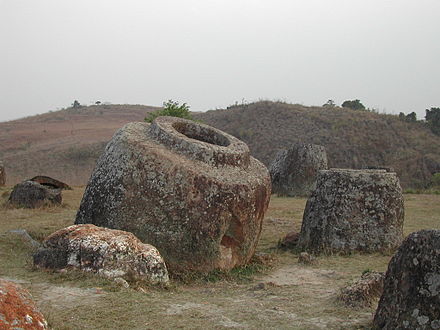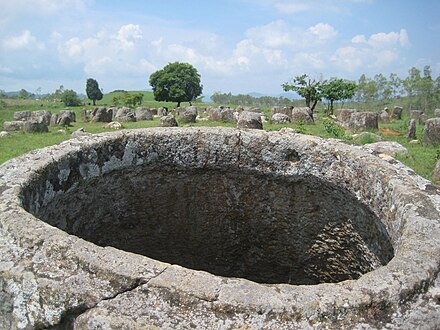Plain of Jars - megalithic archaeological landscape in Laos, consisting of thousands of stone jars scattered around the upland valleys and the lower foothills of the central plain of the Xiangkhoang Plateau
The Plain of Jars is a world heritage site in Central Laos. It consists of thousands of stone jars scattered around the valleys and foothills of the Xiangkhoang Plateau.
Understand
The Plain of Jars combines ancient and contemporary history with insights into Phuan, Hmong, Khmu and Tai Dam culture. Nature encounters are easily accessible off the beaten track.
Unlike ancient Greece or the First Emperor of China that date from around the same time, very little is known about the civilisation that created the Plain of Jars. Excavations have uncovered bones and pots of cremated human remains around the jars. There is a cave at Site 1 that was used for cremations. It is theorized that the jars were used to store bodies for 1-2 years before the bones were cremated and buried.
In the 1960s and 1970s, the area suffered badly due to heavy bombardment by Americans during the Vietnam War. The locals have found imaginative ways to rebuild their lives and surroundings, sometimes using the remnants as part of their daily life; bomb fragments became spoons, and a distinct Xiengkhouang-style of architecture has been created, incorporating bombshells as building material and décor for houses.
Get in
By plane
The nearest airport is in Phonsavan. Lao Airlines offers six flights a week in peak season and four flights in low season to Vientiane.
By bus
If you are travelling to Phonsavan from Vientiane you can take either VIP buses or local buses. The buses leave from the northern bus terminal and take about 10-12 hours. The roads are paved but there are plenty of bends. The bus trip from Vang Vieng takes 7-8 hours. Buses run daily from Luang Prabang via Rte 13 and 7 and take 8 hours. You could also hire a minivan in either Luang Prabang or Vientiane.
Coming from Vinh or Hanoi in Vietnam, visas are available on arrival at the Nam Ka border crossing, which is open daily from 06:00–18:00. The bus from Vinh leaves four days a week and takes 12 hours. There is one per week from Hanoi.
Get around
To get to other towns in the province you can take local buses or pick-up trucks. Travel agents in Phonsavan arrange bike, motorbike and car rentals. A bike costs depending on quality from 20,000 kip per day. You can rent scooters for about 100,000 kip/day (70,000 kip in low season). The roads to the Site 1 are paved or in very good state. To rent a minivan costs about USD50-80, a four-wheel-drive costs over USD100. Depending on the company, the cost either includes or excludes petrol. All prices greatly vary depending on season and availability.
Motorbike are available for rent. All of them are semi-automatic, so you do not have to be an experienced biker. You can visit all three jar sites, but sites 2 and 3 can get a little tricky if it rains. You may not go to few other places like War Spoon Village unless you have an expensive tour guide. Even if it is a planned move by the tour companies, it still is fun to ride through the villages. Ask for a map at the rental place or your guest house.
You can also bicycle to jar site 1 from Phonsavan. Depending which map you believe, it's 8-15 km away and although the roads have some inclines it's possible to cycle there without being especially fit (maximum 45 min). It's easy to find: the junction off the main road is signposted and from that village it's 2.5 km. Parking your bike at Jar site 1 costs 2,000 kip on top of the entrance fee. If your arrive before 07:00, the site is deserted and nobody will ask for an entrance or parking fee.
See
In Phonsavan, many companies offer tours of the Plain of Jars and around surrounding villages and other sights. See the Phonsavan section for activities and attractions around the Plain of Jars.
There are hundreds of jars at the various sites. Some were damaged in the Indochina War and some during the invasion of Chinese bandits. They are showing wear and tear caused by tourists climbing on them. Some of the sites have impressive bomb craters and jars split by the force of the bombing.
Jar Site 1 is one of the most impressive and the easiest to get to. Entrance fee to Site 1 is 15,000 kip and to Site 2 and 3 10,000 kip each. Take a (motorbike) tour to Jar Sites 2 and 3. However, there are few signs, so don't be afraid to ask local people for the way or look for the blue and white painted sign to go to Site 2 or a spray painted sign on an electric post to find Site 3. There is an easy hike between the two sites, and is suitable for families. The path was cleared of unexploded ordnance in 2007, but visitors are strongly advised to follow the red and white markers.
Other visitable sites include Jar Sites 16, 23 and 52.
Do
Buy
Typical local products from Phonsavanh and the surrounding area are natural dyes and textiles, each with individual pattern depending on the ethnic group, and basketry, mulberry paper umbrellas, spoons and bangles made from war scrap or Hmong embroidery. Taking antiques home from Laos may be illegal.
A special drink is Mastake whisky made from Hed Wai, a highly valued mushroom from the pine forests of Xieng Khoung.
Eat
Don't bank on eating a meal along the road between Phonsavan and Jar Site 1 as once you leave the outskirts there's only one village. You can buy water and snacks. There is a small cafe at Site 1.
The nearest place for food is Phonsavan.
Drink
There are several salabeers around Phonsavan overlooking small lakes. The best to find are opposite Maly Hotel or on the road to the airport near Nam Ngum market.
Sleep
Check the Phonsavan section for hotel descriptions. Phonsavan has a wide range of hotels from simple guesthouses to more luxurious hotels and even a French boutique hotel on top of a mountain.
- Golden Mountain Garden, Phonsavan (Old airport), +856 20 22546888. Good hotel.
Stay safe

During the Laotian Civil War of 1959-1975, a.k.a. the "Secret War", the Plain of Jars was in the middle of contested territory that was heavily bombed by the US and heavily mined by both sides. Decades later, there is still a lot of unexploded ordnance (UXO) on the ground in the valley, which continues to kill or maim Laotians. However, the international NGO Mines Advisory Group (MAG) has worked at demining the area continually since 1994, and special attention was paid to the Plain of Jars sites to make them safe for visitors. Visitors today are quite safe so long as they stay within site boundaries that are clearly marked with MAG marker bricks. The white side of the marker indicates the safe side, and the red side indicates an area that has yet to be checked for mines. To learn more about UXO around the Plain of Jars and the ongoing MAG operations, visit their information centre in central Phonsavan.
Go next
There is a daily (morning) bus to Luang Prabang, with the 8-hour journey costing 95,000 kip (Mar 2020). The many minivans going to Luang Prabang cost around 120,000 kip. There is also a daily bus to Vinh in Vietnam. A night bus to Vientiane, arriving the next morning, costs around 130,000 kip for a VIP bus and 110,000 kip for local bus. See Phonsavan for more details.
Plain of Jars
Date Time:Please wait...Timezone:Asia/VientianeCoordinates:19.46, 103.18
Xiangkhoang
Primary administrative division

